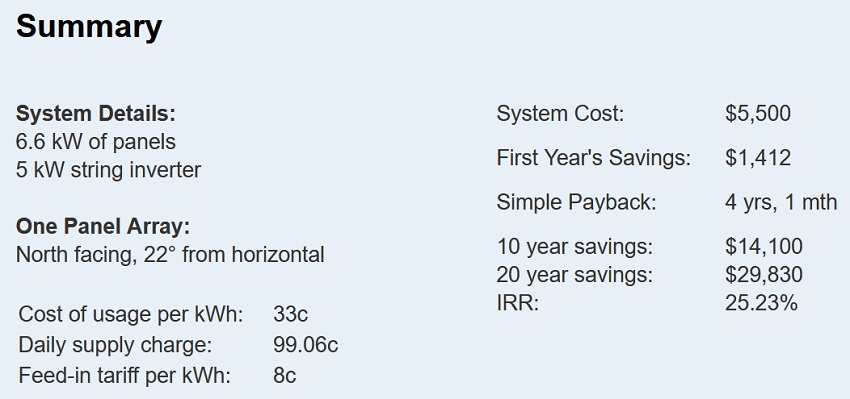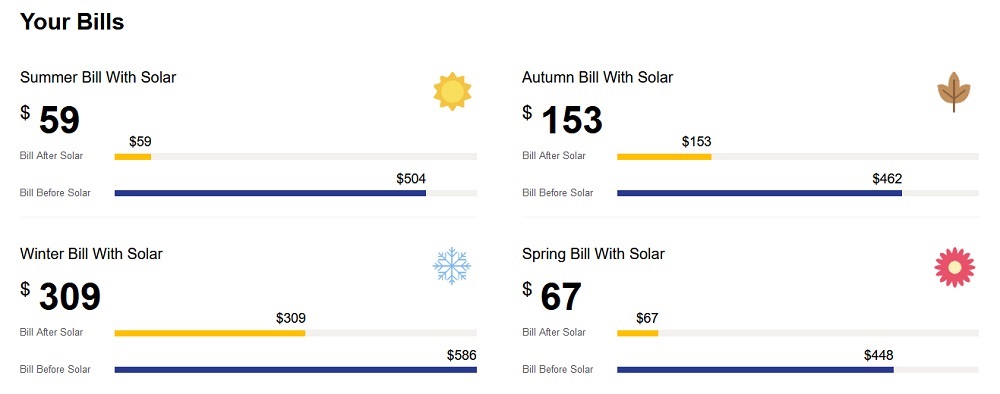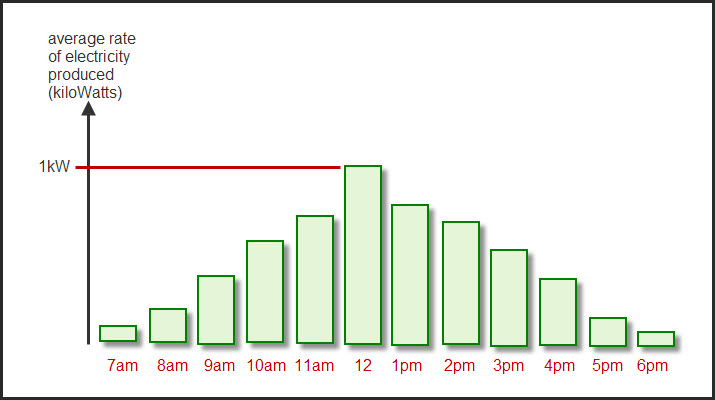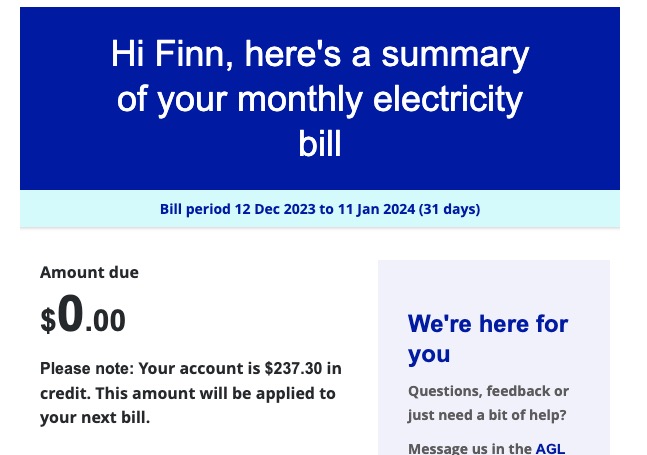How Much Solar Power Do I Need?
Last Updated: 1st Jan 2025
My advice on solar power system sizing has changed over the years due to the cost of solar panels continuing to fall over time.
This video explains the system size providing the best bang for buck for the typical Australian household:
Spoiler alert – if you don’t feel like watching, my advice on system sizing is: “if you have reasonable electricity consumption and a decent feed-in tariff, install as many solar panels as you can fit and afford.”
This article digs a bit deeper into why my advice is to ‘fill your roof’ rather than a specific size and shows how to use my nifty solar calculator to see what a solar system can do to your bills.
But first – some basics.
The size of a solar power system is described by total panel capacity, expressed in kiloWatts (kW).
A Watt is a basic measure of electrical power, and the kilo means there are 1000 of them. i.e. 1 kW = 1000 Watts
For example – a system made up of 16 x 415W solar panels = a 6.6 kW system.
When buying a solar power system, it’s common for installers to quote on ‘oversized’ systems.
The linked article goes into more detail, but in short – you get huge bang for buck by putting on 33% more panels than an inverter is rated for.
This is why 6.6kW solar systems, using 5 kW inverters, are still very popular in 2025 – they represent a sizing ‘sweet spot’ providing value for money while being small enough to fit on nearly all roofs. They’re also the maximum size some Distributed Network Service Providers (DNSP) allow on a single-phase home (more on DNSPs below).
Note when you have an ‘oversized’ system, you will never produce more power than what the inverter is rated for. For example, a 6.6 kW solar system using a 5 kW inverter will never produce more than 5 kW at any given point in time.
People assume this would result in ‘lost’ energy generation due to ‘clipping’ of production at 5 kW. But because solar panels only rarely approach their maximum rated output, averaged over a year you lose very little – so don’t stress.
A word of caution: Be sure to understand what an installer is quoting you on. Make sure it is the solar PV peak Watts of the solar panels and NOT the inverter size they are quoting. In the past, I’ve seen advertising selling a “10 kW system” consisting of a 10 kW inverter with only 8 kW of solar panels!
To give you a feel for the amount of power a kilowatt represents, the table below shows what you can run with 1 kW of power:
- 100 x 10W LED globes
- 10 x 65″ LED TVs
- 1 x Hot water heat pump
- 1 x pool pump
- A small split system air conditioner
Wow, so could you power 100 globes with a 1 kW solar power system? Kind of.
A 1 kW solar panel system will only produce 1 kW of power around midday and only if it is a clear, cool sunny day. So your 100 globes would only be all on for a tiny part of the day.
The graph below shows what the electricity output of a 1 kW solar power system might look like over a summer’s day. You can see that 1 kW is only generated at midday when the sun is at its strongest:
This is why most solar systems are connected to the electricity grid. The grid will absorb any electricity generated by the solar panels not used by your home. When you use more electricity than can be produced by the sun (and at night, of course), the grid automatically meets your electricity needs.
How many solar panels will you need to offset your electricity usage?
First – I want to address most people’s motivation for going solar: “I want to put on solar panels and get my electricity bill to zero!”
Getting a zero dollar bill isn’t as simple as installing enough solar panels to generate your average daily usage. As I explained previously, when you use electricity is almost as important as the amount of electricity you use. This is because a solar system only generates its maximum at midday on a ‘good’ day.
Solar power won’t affect a massive electricity bill regardless of system size if it’s all caused by overnight air-conditioner usage.
Getting zero bills with only solar panels – and no battery storage – is possible. I used to get credits on my electricity bill with a 6 KW solar system – until I got an electric car. But my bills are back in credit now I’ve upgraded to a 20 kW solar system.
Yup – my retailer is paying me for being connected to the electricity network!
But – for those of you with sky-high energy costs and not enough room for a huge solar power system, it’s important to focus on how much solar energy can reduce your bills, not whether or not it can simply get your bills to $0.
Or, to put it another way – if solar power could take your $500 quarterly bill down to $50, would you be annoyed you didn’t get your fabled ‘$0 bill’, or would you be jumping for joy that your solar system saved you $450 in 3 months?
Now – let’s get into some hard numbers on system sizes with the help of my solar calculator.
An example for a typical home in Sydney
Let’s take a home in Sydney with $500 quarterly electricity bills, paying $0.33 per kWh for grid electricity and getting paid a $0.8 per kWh feed-in tariff. They paid $6,000 for a north-facing 6.6 kW solar system and have 26% solar electricity self-consumption.
Putting these assumptions into my calculator yields the following result:

Or, to look at it from the perspective of “What will my electricity bills be before/after solar?”:

So – a 6.6 kW system in Sydney, assuming 26% solar energy self-consumption, won’t quite get a $500 quarterly bill to $0 – but, on average, it gets well over halfway there!
If this home could fit more than 6.6kW on their roof and installed a large 13kW system – with the same consumption patterns they’d be over $150 in credit each year.
What roadblocks are there to filling your roof with solar panels?
Besides the obvious (physical roof size/space and your budget), the other obstacle preventing you from maxing out your roof with panels are limitations set by your “Distributed Network Service Provider”, or DNSP.
You can see all of the DNSP rules for each state here.
But, to use an example, here in South Australia, SA Power Networks (SAPN) is our only DNSP.
They have set system size limits of:
- Single-phase homes: 10 kW inverter limit, 5 kW export limit.
- Three-phase homes: 30 kW inverter limit, 15 kW export limit.
Meaning – if you have a single-phase home in SA, you could have up to 13.3 kW of solar panels on your roof with a 10 kW inverter. Remember – you can oversize an inverter by 33%. But – you’d be export limited to 5 kW
Export limitations mean your inverter will intelligently ramp down solar power production to ensure a maximum of 5 kW is sent to the grid at any one time.
Some homeowners ask me “If my energy needs are low-to-moderate, isn’t it pointless to install a large system if I’m export limited?”
The answer, surprisingly, is no. You lose less generation than you’d expect with export limitation due to a variety of factors.
Why bigger is better, even if you believe you won’t need a larger system
Even with feed-in tariffs dropping and export limitations for single-phase homes in some locations, maxing out your roof with solar panels is a smart move for two reasons:
- Winter and summer are typically the highest energy usage seasons for households. But in summer, solar power systems pump out a ton of energy, so they can help offset big electricity bills easily. In winter, your solar energy generation can be less than half of what it is in summer, so big winter bills are harder to offset unless you have a larger solar system (10 kW or more).
- Future-proofing. I believe by 2030 many homes will have battery storage and electric cars.
Batteries and electric cars need lots of solar generation to charge reliably from the sun, and then you need more solar electricity to offset the energy needs of the rest of your home.
I recently installed more solar panels because my home now has two electric cars and a Tesla Powerwall battery. My previous 6kW system struggled to generate enough energy for them all.
I’ll finish by saying – while I regularly hear from homeowners who wish they put on more solar panels when they had the chance (because it’s expensive and a technical headache to add panels to an existing system), I have never heard anyone complain they’ve installed too much solar power.

